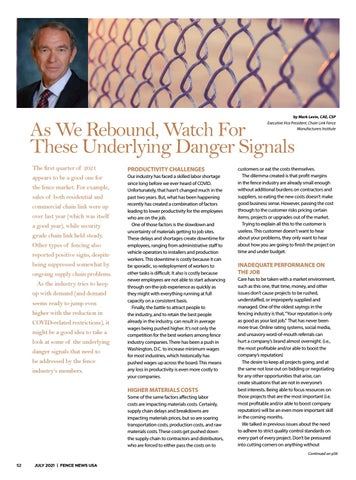by Mark Levin, CAE, CSP Executive Vice President, Chain Link Fence Manufacturers Institute
As We Rebound, Watch For These Underlying Danger Signals The first quarter of 2021 appears to be a good one for the fence market. For example, sales of both residential and commercial chain link were up over last year (which was itself a good year), while security grade chain link held steady. Other types of fencing also reported positive signs, despite being suppressed somewhat by ongoing supply chain problems. As the industry tries to keep up with demand (and demand seems ready to jump even higher with the reduction in COVID-related restrictions), it might be a good idea to take a look at some of the underlying danger signals that need to be addressed by the fence industry’s members.
PRODUCTIVITY CHALLENGES Our industry has faced a skilled labor shortage since long before we ever heard of COVID. Unfortunately, that hasn’t changed much in the past two years. But, what has been happening recently has created a combination of factors leading to lower productivity for the employees who are on the job. One of those factors is the slowdown and uncertainty of materials getting to job sites. These delays and shortages create downtime for employees, ranging from administrative staff to vehicle operators to installers and production workers. This downtime is costly because it can be sporadic, so redeployment of workers to other tasks is difficult. It also is costly because newer employees are not able to start advancing through on-the-job experience as quickly as they might with everything running at full capacity on a consistent basis. Finally, the battle to attract people to the industry, and to retain the best people already in the industry, can result in average wages being pushed higher. It’s not only the competition for the best workers among fence industry companies. There has been a push in Washington, D.C. to increase minimum wages for most industries, which historically has pushed wages up across the board. This means any loss in productivity is even more costly to your companies.
HIGHER MATERIALS COSTS Some of the same factors affecting labor costs are impacting materials costs. Certainly, supply chain delays and breakdowns are impacting materials prices, but so are soaring transportation costs, production costs, and raw materials costs. These costs get pushed down the supply chain to contractors and distributors, who are forced to either pass the costs on to
customers or eat the costs themselves. The dilemma created is that profit margins in the fence industry are already small enough without additional burdens on contractors and suppliers, so eating the new costs doesn’t make good business sense. However, passing the cost through to the customer risks pricing certain items, projects or upgrades out of the market. Trying to explain all this to the customer is useless. This customer doesn’t want to hear about your problems, they only want to hear about how you are going to finish the project on time and under budget.
INADEQUATE PERFORMANCE ON THE JOB Care has to be taken with a market environment, such as this one, that time, money, and other issues don’t cause projects to be rushed, understaffed, or improperly supplied and managed. One of the oldest sayings in the fencing industry is that, “Your reputation is only as good as your last job.” That has never been more true. Online rating systems, social media, and unsavory word-of-mouth referrals can hurt a company’s brand almost overnight. (i.e., the most profitable and/or able to boost the company’s reputation) The desire to keep all projects going, and at the same not lose out on bidding or negotiating for any other opportunities that arise, can create situations that are not in everyone’s best interests. Being able to focus resources on those projects that are the most important (i.e. most profitable and/or able to boost company reputation) will be an even more important skill in the coming months. We talked in previous issues about the need to adhere to strict quality control standards on every part of every project. Don’t be pressured into cutting corners on anything without Continued on p56
52
JULY 2021 | FENCE NEWS USA
















